This is “Managing Firm Resources”, chapter 4 from the book Strategic Management: Evaluation and Execution (v. 1.0). For details on it (including licensing), click here.
For more information on the source of this book, or why it is available for free, please see the project's home page. You can browse or download additional books there. To download a .zip file containing this book to use offline, simply click here.
Chapter 4 Managing Firm Resources
Learning Objectives
After reading this chapter, you should be able to understand and articulate answers to the following questions:
- What is resource-based theory, and why is it important to organizations?
- In what ways can intellectual property serve as a value-added resource for organizations?
- How should executives use the value chain to maximize the performance of their organizations?
- What is SWOT analysis and how can it help an organization?
Southwest Airlines: Let Your LUV Flow
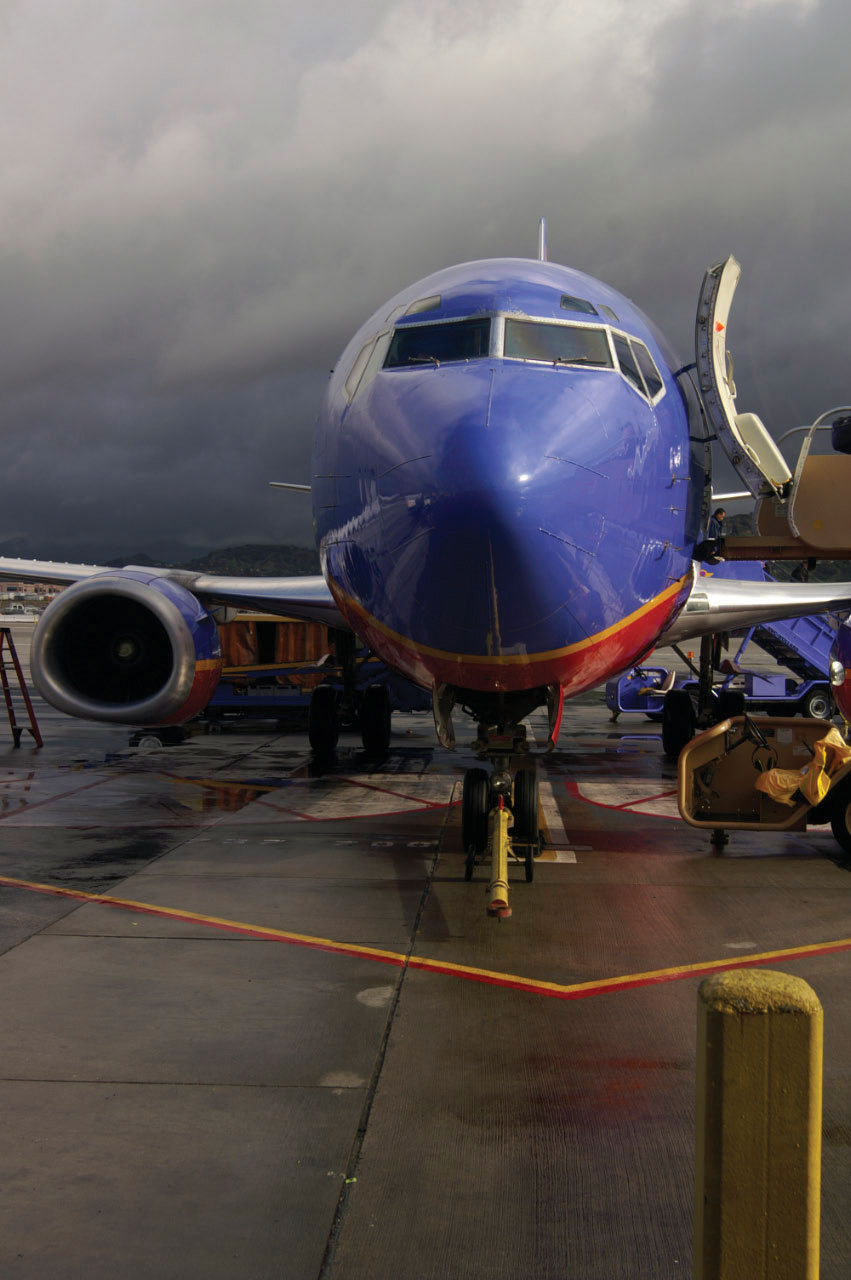
Southwest Airlines’ acquisition of AirTran in 2011 may lead the firm into stormy skies.
Image courtesy of Stuart Seeger, http://en.wikipedia.org/wiki/File:Southwest_737_At_Burbank.jpg
In 1971, an upstart firm named Southwest Airlines opened for business by offering flights between Houston, San Antonio, and its headquarters at Love Field in Dallas. From its initial fleet of three airplanes and three destinations, Southwest has grown to operate hundreds of airplanes in scores of cities. Despite competing in an industry that is infamous for bankruptcies and massive financial losses, Southwest marked its thirty-eighth profitable year in a row in 2010.
Why has Southwest succeeded while many other airlines have failed? Historically, the firm has differed from its competitors in a variety of important ways. Most large airlines use a “hub and spoke” system. This type of system routes travelers through a large hub airport on their way from one city to another. Many Delta passengers, for example, end a flight in Atlanta and then take a connecting flight to their actual destination. The inability to travel directly between most pairs of cities adds hours to a traveler’s itinerary and increases the chances of luggage being lost. In contrast, Southwest does not have a hub airport; preferring instead to connect cities directly. This helps make flying on Southwest attractive to many travelers.
Southwest has also been more efficient than its rivals. While most airlines use a variety of different airplanes, Southwest operates only one type of jet: the Boeing 737. This means that Southwest can service its fleet much more efficiently than can other airlines. Southwest mechanics need only the know-how to fix one type of airplane, for example, while their counterparts with other firms need a working knowledge of multiple planes. Southwest also gains efficiency by not offering seat assignments in advance, unlike its competitors. This makes the boarding process move more quickly, meaning that Southwest’s jets spend more time in the air transporting customers (and making money) and less time at the gate relative to its rivals’ planes.
Organizational culture is the dimension along which Southwest perhaps has differed most from its rivals. The airline industry as a whole suffers from a reputation for mediocre (or worse) service and indifferent (sometimes even surly) employees. In contrast, Southwest enjoys strong loyalty and a sense of teamwork among its employees.
One tangible indicator of this culture is Southwest’s stock ticker symbol. Most companies choose stock ticker symbols that evoke their names. Ford’s ticker symbol is F, for example, and Walmart’s symbol is WMT. When Southwest became a publicly traded company in 1977, executives chose LUV as its ticker symbol. LUV pays a bit of homage to the firm’s humble beginnings at Love Field. More important, however, LUV represents the love that executives have created among employees, between employees and the company, and between customers and the company. This “LUV affair” has long been and remains a huge success. As recently as March 2011, for example, Southwest was ranked fourth on Fortune magazine’s World’s Most Admired Company list.
In September 2010, Southwest surprised many observers when it announced that it was acquiring AirTran Airways for $1.4 billion. Southwest and AirTran both emphasized low fares, but they differed in many ways. AirTran routed most of its passengers through a hub-and-spoke system, and it relied on a different plane than Southwest, the Boeing 717. The acquisition of AirTran thus raised important questions about Southwest’s future.Schlangenstein, M., & Hughes, J. 2010, September 28. Southwest risks keep-it-simple focus to spur growth. Retrieved from http://www.washingtonpost.com/wp-dyn/content/article/2010/09/28/AR2010092801578.html How would AirTran’s hub-and-spoke system be integrated with Southwest’s nonhub approach? Could the airlines’ respective fleets of 737s and 717s be joined without losing efficiency? Perhaps most important, could Southwest maintain its legendary organizational culture while taking over a sizable rival and integrating AirTran’s thousands of employees? When the acquisition was finalized on May 2, 2011, it remained unclear whether Southwest was flying off course or whether Southwest’s “LUV story” would continue for many years.
4.1 Resource-Based Theory
Learning Objectives
- Define the four characteristics of resources that lead to sustained competitive advantage as articulated by the resource-based theory of the firm.
- Understand the difference between resources and capabilities.
- Be able to explain the difference between tangible and intangible resources.
- Know the elements of the marketing mix.
Figure 4.1 Resource-Based Theory: The Basics
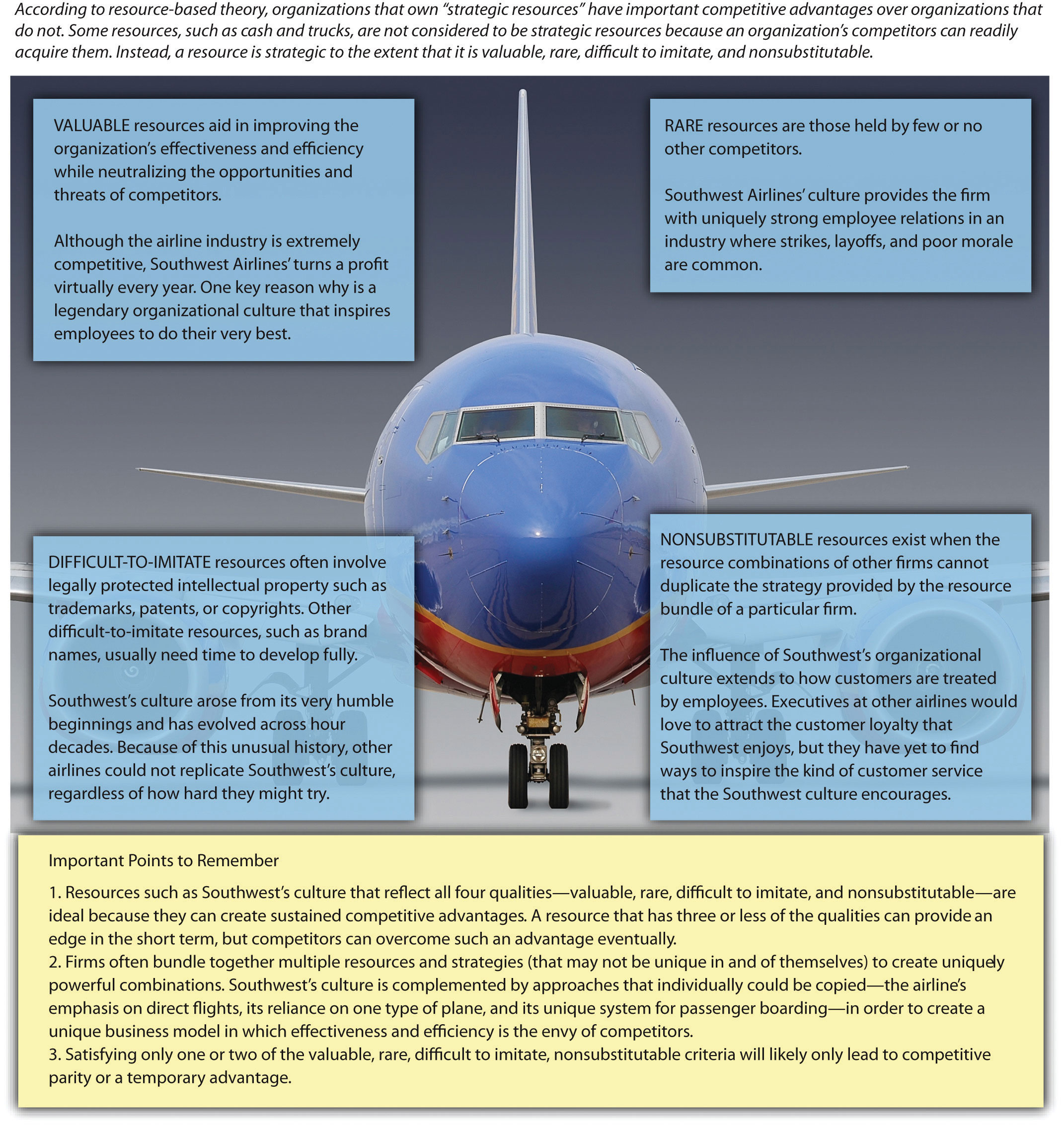
© Thinkstock
Four Characteristics of Strategic Resources
Southwest Airlines provides an illustration of resource-based theory in action. Resource-based theoryA theory that contends that the possession of strategic resources can provide an organization with competitive advantages over its rivals. contends that the possession of strategic resources provides an organization with a golden opportunity to develop competitive advantages over its rivals (Figure 4.1 "Resource-Based Theory: The Basics"). These competitive advantages in turn can help the organization enjoy strong profits.Barney, J. B. 1991. Firm resources and sustained competitive advantage. Journal of Management, 17, 99–120; Wernerfelt, B. 1984. A resource-based view of the firm. Strategic Management Journal, 5, 171–180.
A strategic resource is an asset that is valuable, rare, difficult to imitate, and nonsubstitutable.Barney, J. B. 1991. Firm resources and sustained competitive advantage. Journal of Management, 17, 99–120; Chi, T. 1994. Trading in strategic resources: Necessary conditions, transaction cost problems, and choice of exchange structure. Strategic Management Journal, 15(4), 271–290. A resource is valuableResources that help a firm create strategies that capitalize on opportunities and ward off threats. to the extent that it helps a firm create strategies that capitalize on opportunities and ward off threats. Southwest Airlines’ culture fits this standard well. Most airlines struggle to be profitable, but Southwest makes money virtually every year. One key reason is a legendary organizational culture that inspires employees to do their very best. This culture is also rareResources that are unique when contrasted with the resources of competitors. in that strikes, layoffs, and poor morale are common within the airline industry.
Competitors have a hard time duplicating resources that are difficult to imitateResources that cannot be easily duplicated by competitors and are often protected by various legal means, including trademarks, patents, and copyrights.. Some difficult to imitate resources are protected by various legal means, including trademarks, patents, and copyrights. Other resources are hard to copy because they evolve over time and they reflect unique aspects of the firm. Southwest’s culture arose from its very humble beginnings. The airline had so little money that at times it had to temporarily “borrow” luggage carts from other airlines and put magnets with the Southwest logo on top of the rivals’ logo. Southwest is a “rags to riches” story that has evolved across several decades. Other airlines could not replicate Southwest’s culture, regardless of how hard they might try, because of Southwest’s unusual history.
A resource is nonsubstitutableResources that exist when competitors cannot find alternative ways to gain the benefits that a resource provides. when competitors cannot find alternative ways to gain the benefits that a resource provides. A key benefit of Southwest’s culture is that it leads employees to treat customers well, which in turn creates loyalty to Southwest among passengers. Executives at other airlines would love to attract the customer loyalty that Southwest enjoys, but they have yet to find ways to inspire the kind of customer service that the Southwest culture encourages.
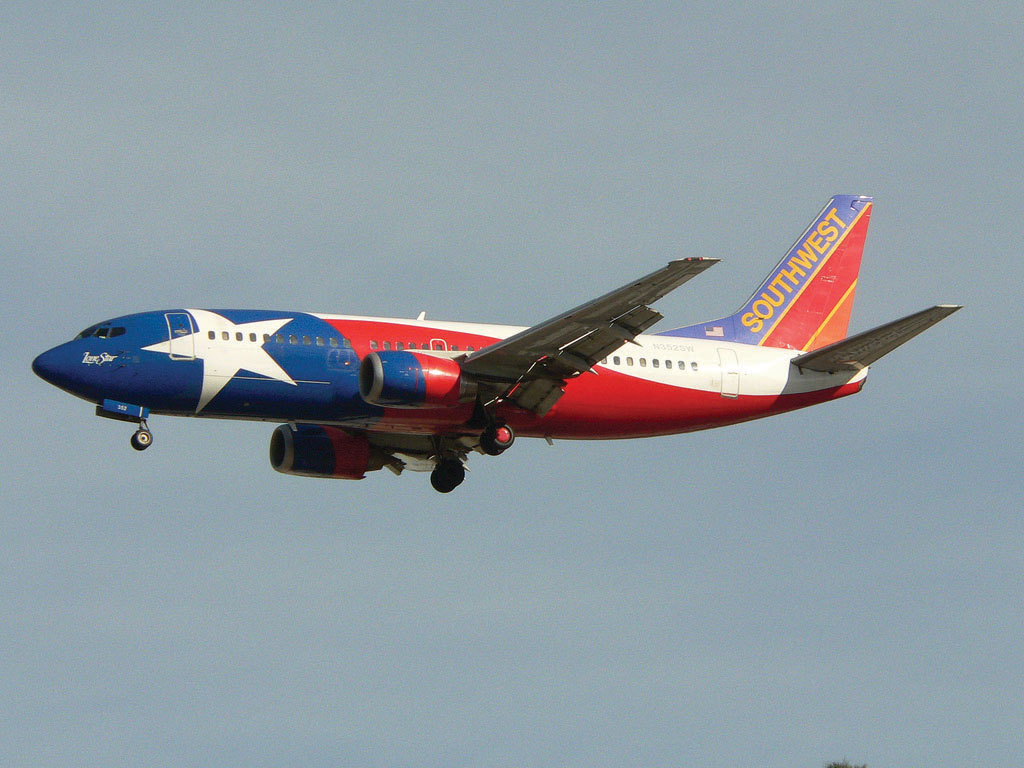
Southwest Airlines’ unique culture is reflected in the customization of their aircraft over the years, such as the “Lone Star One” design.
Image courtesy of planephotoman, http://en.wikipedia.org/wiki/File:Southwest_737_Lonestar_One.jpg.
Ideally, a firm will have a culture, like Southwesta firm will own resources like Southwest’s culture#8217;s, that embraces the four qualities shown in Figure 4.1 "Resource-Based Theory: The Basics". that have all four of these qualities. If so, these resources can provide not only a competitive advantage but also a sustained competitive advantageA competitive advantage that will endure over time.—one that will endure over time and help the firm stay successful far into the future. Resources that do not have all four qualities can still be very useful, but they are unlikely to provide long-term advantages. A resource that is valuable and rare but that can be imitated, for example, might provide an edge in the short term, but competitors can overcome such an advantage eventually.
Resource-based theory also stresses the merit of an old saying: the whole is greater than the sum of its parts. Specifically, it is also important to recognize that strategic resources can be created by taking several strategies and resources that each could be copied and bundling them together in a way that cannot be copied. For example, Southwest’s culture is complemented by approaches that individually could be copied—the airline’s emphasis on direct flights, its reliance on one type of plane, and its unique system for passenger boarding—to create a unique business model whose performance is without peer in the industry.
Resource-based theory can be confusing because the term resources is used in many different ways within everyday common language. It is important to distinguish strategic resources from other resources. To most individuals, cash is an important resource. Tangible goods such as one’s car and home are also vital resources. When analyzing organizations, however, common resources such as cash and vehicles are not considered to be strategic resources. Resources such as cash and vehicles are valuable, of course, but an organization’s competitors can readily acquire them. Thus an organization cannot hope to create an enduring competitive advantage around common resources.
On occasion, events in the environment can turn a common resource into a strategic resource. Consider, for example, a very generic commodity: water. Humans simply cannot live without water, so water has inherent value. Also, water cannot be imitated (at least not on a large scale), and no other substance can substitute for the life-sustaining properties of water. Despite having three of the four properties of strategic resources, water in the United States has remained cheap. Yet this may be changing. Major cities in hot climates such as Las Vegas, Los Angeles, and Atlanta are confronted by dramatically shrinking water supplies. As water becomes more and more rare, landowners in Maine stand to benefit. Maine has been described as “the Saudi Arabia of water” because its borders contain so much drinkable water. It is not hard to imagine a day when companies in Maine make huge profits by sending giant trucks filled with water south and west or even by building water pipelines to service arid regions.
Figure 4.2 Resources and Capabilities
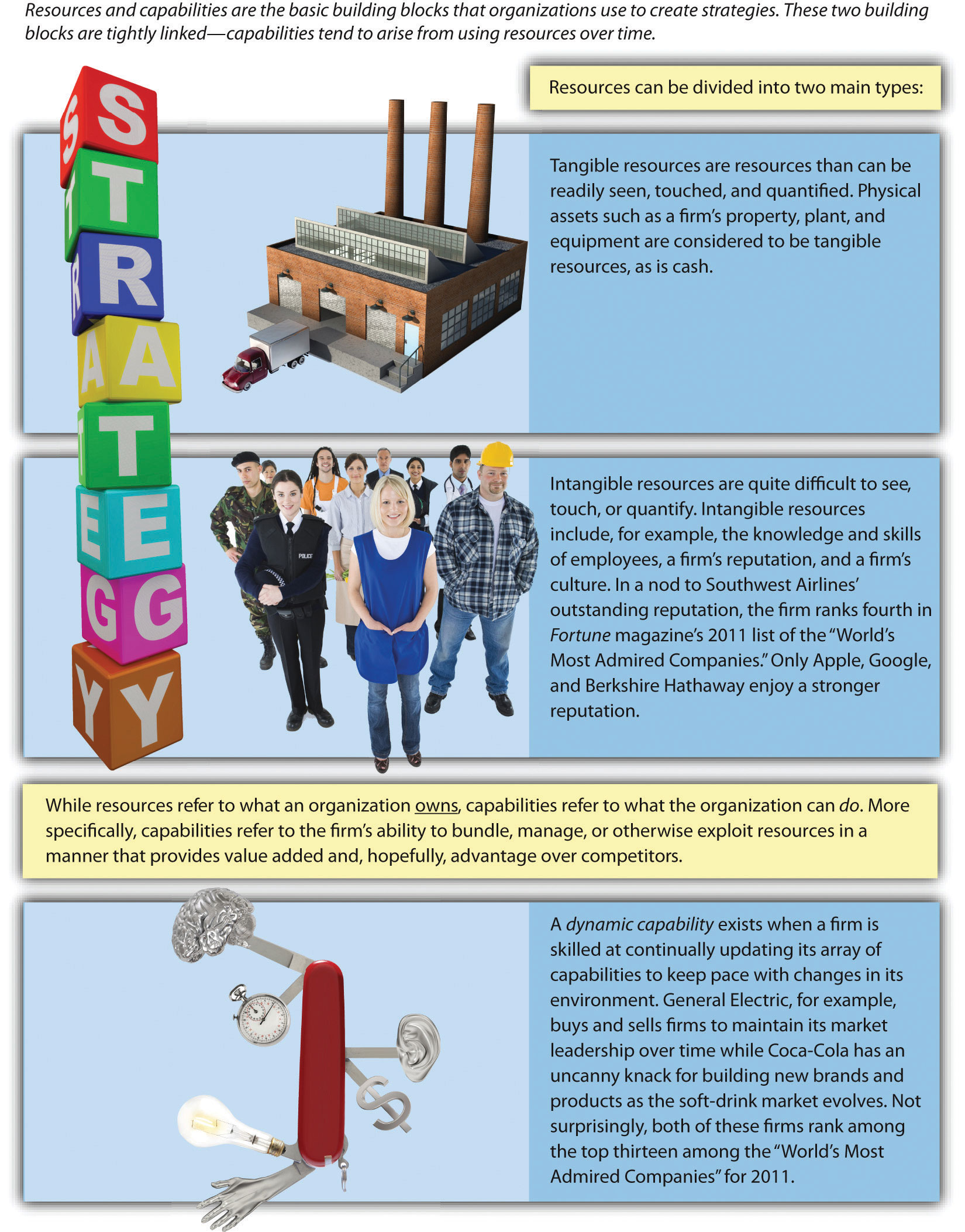
© Thinkstock
From Resources to Capabilities
The tangibility of a firm’s resources is an important consideration within resource-based theory. Tangible resourcesResources than can be readily seen, touched, and quantified, such as physical assets, property, plant, equipment, and cash. are resources that can be readily seen, touched, and quantified. Physical assets such as a firm’s property, plant, and equipment, as well as cash, are considered to be tangible resources. In contrast, intangible resourcesResources that are difficult to see, to touch, or to quantify, such as the knowledge and skills of employees, a firm’s reputation, and a firm’s culture. are quite difficult to see, to touch, or to quantify. Intangible resources include, for example, the knowledge and skills of employees, a firm’s reputation, and a firm’s culture. In comparing the two types of resources, intangible resources are more likely to meet the criteria for strategic resources (i.e., valuable, rare, difficult to imitate, and nonsubstitutable) than are tangible resources. Executives who wish to achieve long-term competitive advantages should therefore place a premium on trying to nurture and develop their firms’ intangible resources.
CapabilitiesWhat the organization can do based on the resources it possesses. are another key concept within resource-based theory. A good and easy-to-remember way to distinguish resources and capabilities is this: resources refer to what an organization owns, capabilities refer to what the organization can do (Figure 4.2 "Resources and Capabilities"). Capabilities tend to arise over time as a firm takes actions that build on its strategic resources. Southwest Airlines, for example, has developed the capability of providing excellent customer service by building on its strong organizational culture. Capabilities are important in part because they are how organizations capture the potential value that resources offer. Customers do not simply send money to an organization because it owns strategic resources. Instead, capabilities are needed to bundle, to manage, and otherwise to exploit resources in a manner that provides value added to customers and creates advantages over competitors.
Some firms develop a dynamic capabilityA unique ability to create new capabilities by continually updating a firm’s array of capabilities to keep pace with changes in its environment.. This means that a firm has a unique capability of creating new capabilities. Said differently, a firm that enjoys a dynamic capability is skilled at continually updating its array of capabilities to keep pace with changes in its environment. General Electric, for example, buys and sells firms to maintain its market leadership over time, while Coca-Cola has an uncanny knack for building new brands and products as the soft-drink market evolves. Not surprisingly, both of these firms rank among the top thirteen among the “World’s Most Admired Companies” for 2011.
Strategy at the Movies
That Thing You Do!
How can the members of an organization reach success “doing that thing they do”? According to resource-based theory, one possible road to riches is creating—on purpose or by accident—a unique combination of resources. In the 1996 movie That Thing You Do!, unwittingly assembling a unique bundle of resources leads a 1960s band called The Wonders to rise from small-town obscurity to the top of the music charts. One resource is lead singer Jimmy Mattingly, who possesses immense musical talent. Another is guitarist Lenny Haise, whose fun attitude reigns in the enigmatic Mattingly. Although not a formal band member, Mattingly’s girlfriend Faye provides emotional support to the group and even suggests the group’s name. When the band’s usual drummer has to miss a gig due to injury, the door is opened for charismatic drummer Guy Patterson, whose energy proves to be the final piece of the puzzle for The Wonders.
Despite Mattingly’s objections, Guy spontaneously adds an up-tempo beat to a sleepy ballad called “That Thing You Do!” during a local talent contest. When the talent show audience goes crazy in response, it marks the beginning of a meteoric rise for both the song and the band. Before long, The Wonders perform on television and “That Thing You Do!” is a top-ten hit record. The band’s magic vanishes as quickly as it appeared, however. After their bass player joins the Marines, Lenny elopes on a whim, and Jimmy’s diva attitude runs amok, the band is finished and Guy is left to “wonder” what might have been. That Thing You Do! illustrates that while bundling resources in a unique way can create immense success, preserving and managing these resources over time can be very difficult.

Liv Tyler plays Faye Dolan, the love interest of drummer Guy Patterson, in That Thing You Do!
Image courtesy of Daniel Dormann, http://en.wikipedia.org/wiki/File:LivTylerJune08.jpg.
Is Resource-Based Theory Old News?
Resource-based theory has evolved in recent years to provide a way to understand how strategic resources and capabilities allow firms to enjoy excellent performance. But more than one wry observer has wondered aloud, “Is resource-based theory just old wine in a new bottle?” This is a question worth considering because the role of resources in shaping success and failure has been discussed for many centuries.
Aesop was a Greek storyteller who lived approximately 2,500 years ago. Aesop is known in particular for having created a series of fables—stories that appear on the surface to be simply children’s tales but that offer deep lessons for everyone. One of Aesop’s fables focuses on an ass (donkey) and some grasshoppers. When the ass tries to duplicate the sweet singing of the grasshoppers by copying their diet, he soon dies of starvation. Attempting to replicate the grasshoppers’ unique singing capability proved to be a fatal mistake (Figure 4.3 "Aesop’s Fables"). The fable illustrates a central point of resource-based theory: it is an array of resources and capabilities that fuels enduring success, not any one resource alone.
In a far more recent example, sociologist Philip Selznick developed the concept of distinctive competenceA set of activities that an organization performs especially well. through a series of books in the 1940s and 1950s.Selznick, P. 1957. Leadership in administration. New York: Harper; Selznick, P. 1952. The organizational weapon. New York, NY: McGraw-Hill; Selznick, P. 1949. TVA and the grass roots. Berkeley, CA: University of California Press. A distinctive competence is a set of activities that an organization performs especially well. Southwest Airlines, for example, appears to have a distinctive competency in operations, as evidenced by how quickly it moves its flights in and out of airports. Further, Selznick suggested that possessing a distinctive competency creates a competitive advantage for a firm. Certainly, there is plenty of overlap between the concept of distinctive competency, on the one hand, and capabilities, on the other.
Figure 4.3 Aesop’s Fables
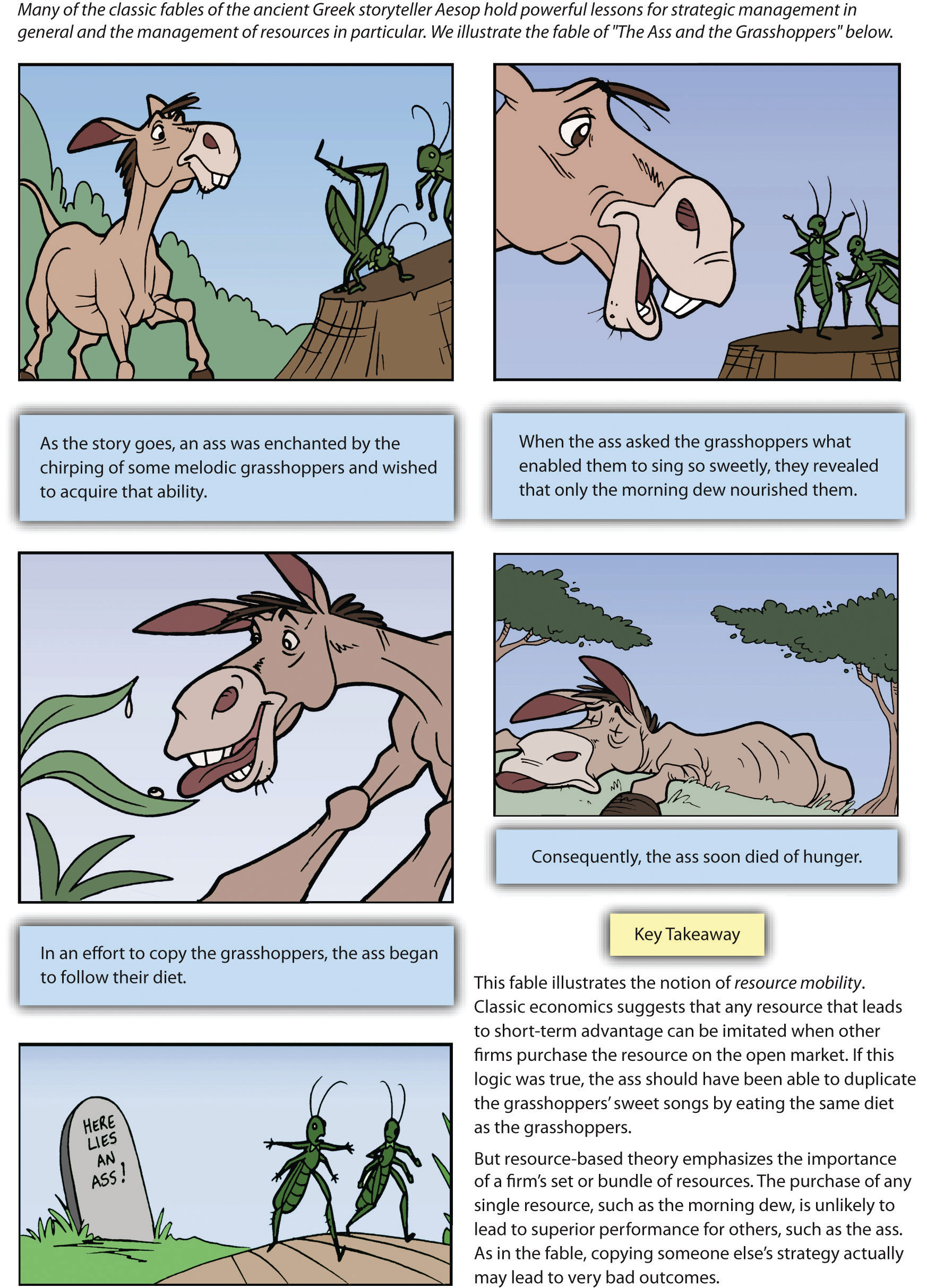
Adapted from Chapter 4 of Atlas Black: Managing to Succeed and Short, J. & Ketchen, D. 2005. Using classic literature to teach timeless truths: An illustration using Aesop’s fables to teach strategic management. Journal of Management Education, 29, 6, 816–832.
So is resource-based theory in fact old wine in a new bottle? Not really. Resource-based theory builds on past ideas about resources, but it represents a big improvement on past ideas in at least two ways. First, resource-based theory offers a complete framework for analyzing organizations, not just snippets of valuable wisdom like Aesop and Selznick provided. Second, the ideas offered by resource-based theory have been developed and refined through scores of research studies involving thousands of organizations. In other words, there is solid evidence backing it up.
The Marketing Mix
Figure 4.4 The Marketing Mix
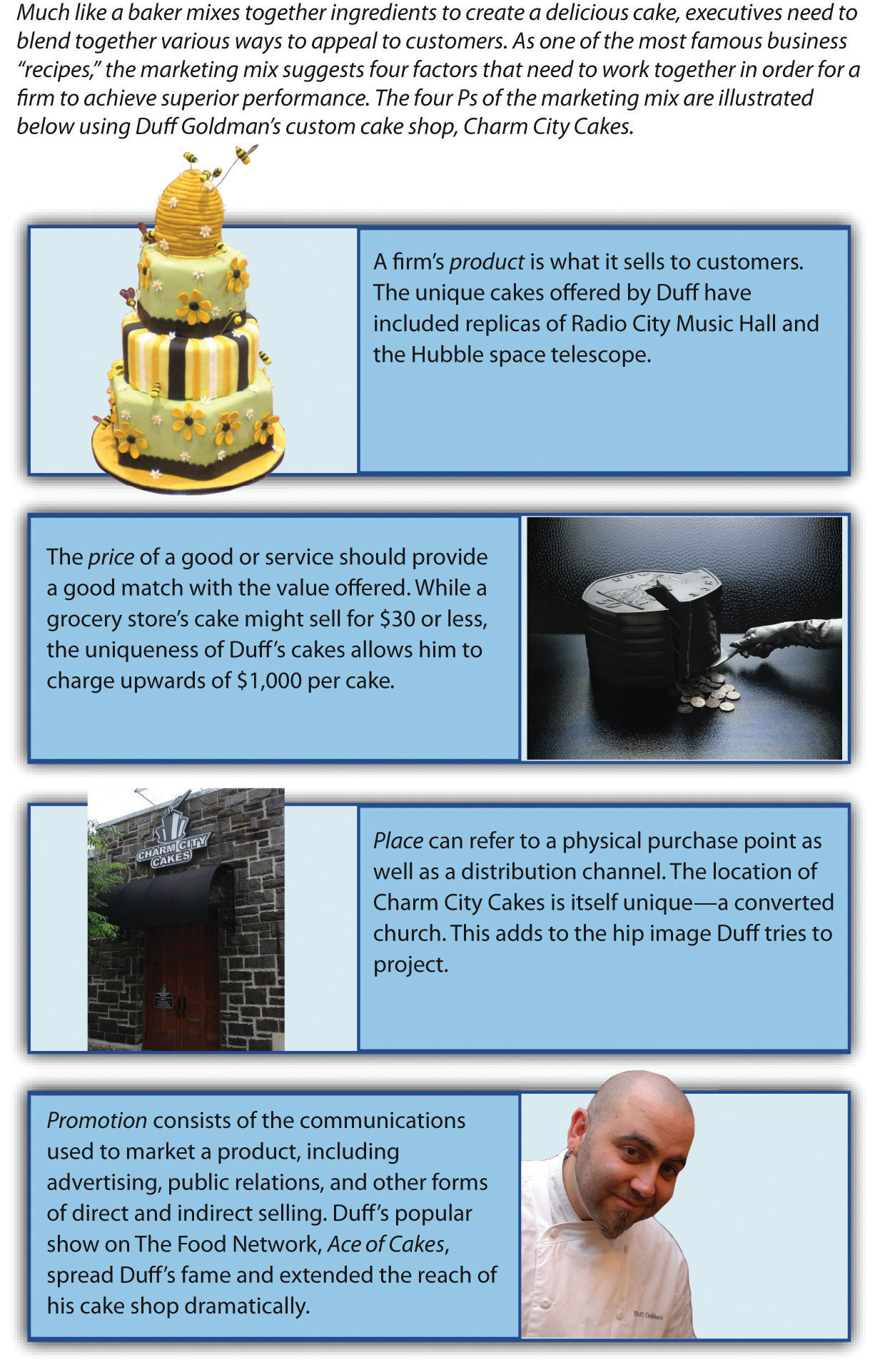
Images courtesy of Adventures of Pam & Frank, http://www.flickr.com/photos/adventurespf/2817730158/ (first); Fuzzy Gerdes, http://www.flickr.com/photos/fuzzy/3546581438/ (third); Extended Image Photography, http://en.wikipedia.org/wiki/File:Duff_Goldman_of_Charm_City_Cakes.jpg (fourth); other images © Thinkstock.
Leveraging resources and capabilities to create desirable products and services is important, but customers must still be convinced to purchase these goods and services. The marketing mixThe four Ps (product, price, place, and promotion) that firms use to offer customers a coherent and persuasive message.—also known as the four Ps of marketing—provides important insights into how to make this happen. A master of the marketing mix was circus impresario P. T. Barnum, who is famous in part for his claim that “there’s a sucker born every minute.” The real purpose of the marketing mix is not to trick customers but rather to provide a strong alignment among the four Ps (product, price, place, and promotion) to offer customers a coherent and persuasive message (Figure 4.4 "The Marketing Mix").
A firm’s productGoods and services a firm sells to customers. is what it sells to customers. Southwest Airlines sells, of course, airplane flights. The airline tries to set its flights apart from those of airlines by making flying fun. This can include, for example, flight attendants offering preflight instructions as a rap. The priceThe amount firms charge for their goods or services. of a good or service should provide a good match with the value offered. Throughout its history, Southwest has usually charged lower airfares than its rivals. PlaceA physical purchase point as well as a distribution channel. can refer to a physical purchase point as well as a distribution channel. Southwest has generally operated in cities that are not served by many airlines and in secondary airports in major cities. This has allowed the firm to get favorable lease rates at airports and has helped it create customer loyalty among passengers who are thankful to have access to good air travel.
Finally, promotionThe communications used to market a product, including advertising, public relations, and other forms of direct and indirect selling. consists of the communications used to market a product, including advertising, public relations, and other forms of direct and indirect selling. Southwest is known for its clever advertising. In a recent television advertising campaign, for example, Southwest lampooned the baggage fees charged by most other airlines while highlighting its more customer-friendly approach to checked luggage. Given the consistent theme of providing a good value plus an element of fun to passengers that is developed across the elements of the marketing mix, it is no surprise that Southwest has been so successful within a very challenging industry.
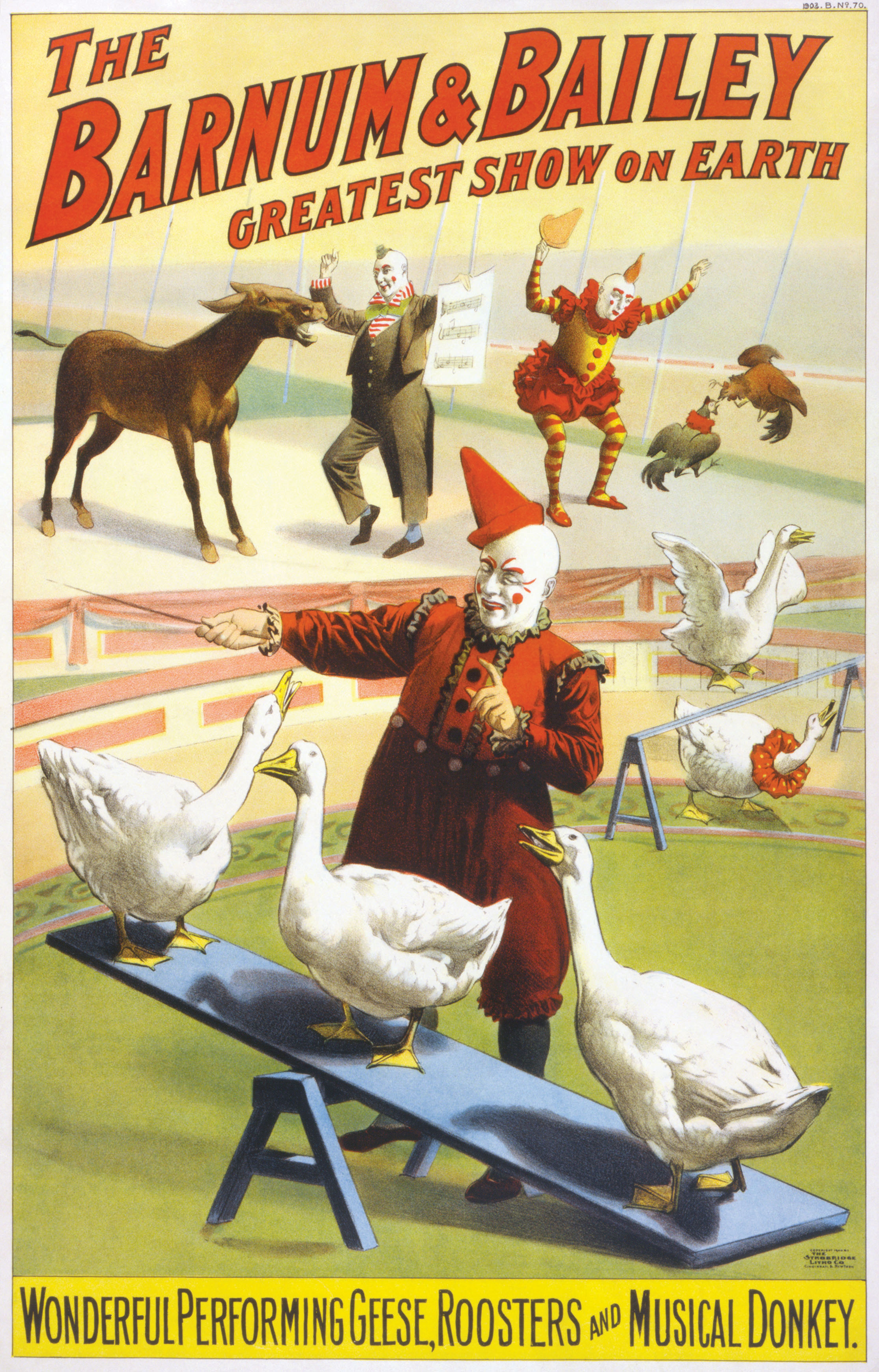
Few executives in history have had the marketing savvy of P. T. Barnum.
Image courtesy of The Strobridge Litho. Co., Cincinnati & New York, http://en.wikipedia.org/wiki/File:Barnum_%26_Bailey_clowns_and_geese2.jpg.
Key Takeaway
- Resource-based theory suggests that resources that are valuable, rare, difficult to imitate, and nonsubstitutable best position a firm for long-term success. These strategic resources can provide the foundation to develop firm capabilities that can lead to superior performance over time. Capabilities are needed to bundle, to manage, and otherwise to exploit resources in a manner that provides value added to customers and creates advantages over competitors.
Exercises
- Does your favorite restaurant have the four qualities of resources that lead to success as articulated by resource-based theory?
- If you were hired by your college or university to market your athletic department, what element of the marketing mix would you focus on first and why?
- What other classic stories or fables could be applied to discuss the importance of firm resources and superior performance?
4.2 Intellectual Property
Learning Objectives
- Define the four major types of intellectual property.
- Be able to provide examples of each intellectual property type.
- Understand how intellectual property can be a valuable resource for firms.
Defining Intellectual Property
The inability of competitors to imitate a strategic resource is a key to leveraging the resource to achieve long–term competitive advantages. Companies are clever, and effective imitation is often very possible. But resources that involve intellectual property reduce or even eliminate this risk. As a result, developing intellectual property is important to many organizations.
Intellectual propertyCreations of the mind, such as inventions, artistic products, and symbols. refers to creations of the mind, such as inventions, artistic products, and symbols. The four main types of intellectual property are patents, trademarks, copyrights, and trade secrets (Figure 4.5 "Types of Intellectual Property"). If a piece of intellectual property is also valuable, rare, and nonsubstitutable, it constitutes a strategic resource. Even if a piece of intellectual property does not meet all four criteria for serving as a strategic resource, it can be bundled with other resources and activities to create a resource.
A variety of formal and informal methods are available to protect a firm’s intellectual property from imitation by rivals. Some forms of intellectual property are best protected by legal means, while defending others depends on surrounding them in secrecy. This can be contrasted with Southwest Airlines’ well-known culture, which rivals are free to attempt to copy if they wish. Southwest’s culture thus is not intellectual property, although some of its complements such as Southwest’s logo and unique color schemes are.
Figure 4.5 Types of Intellectual Property
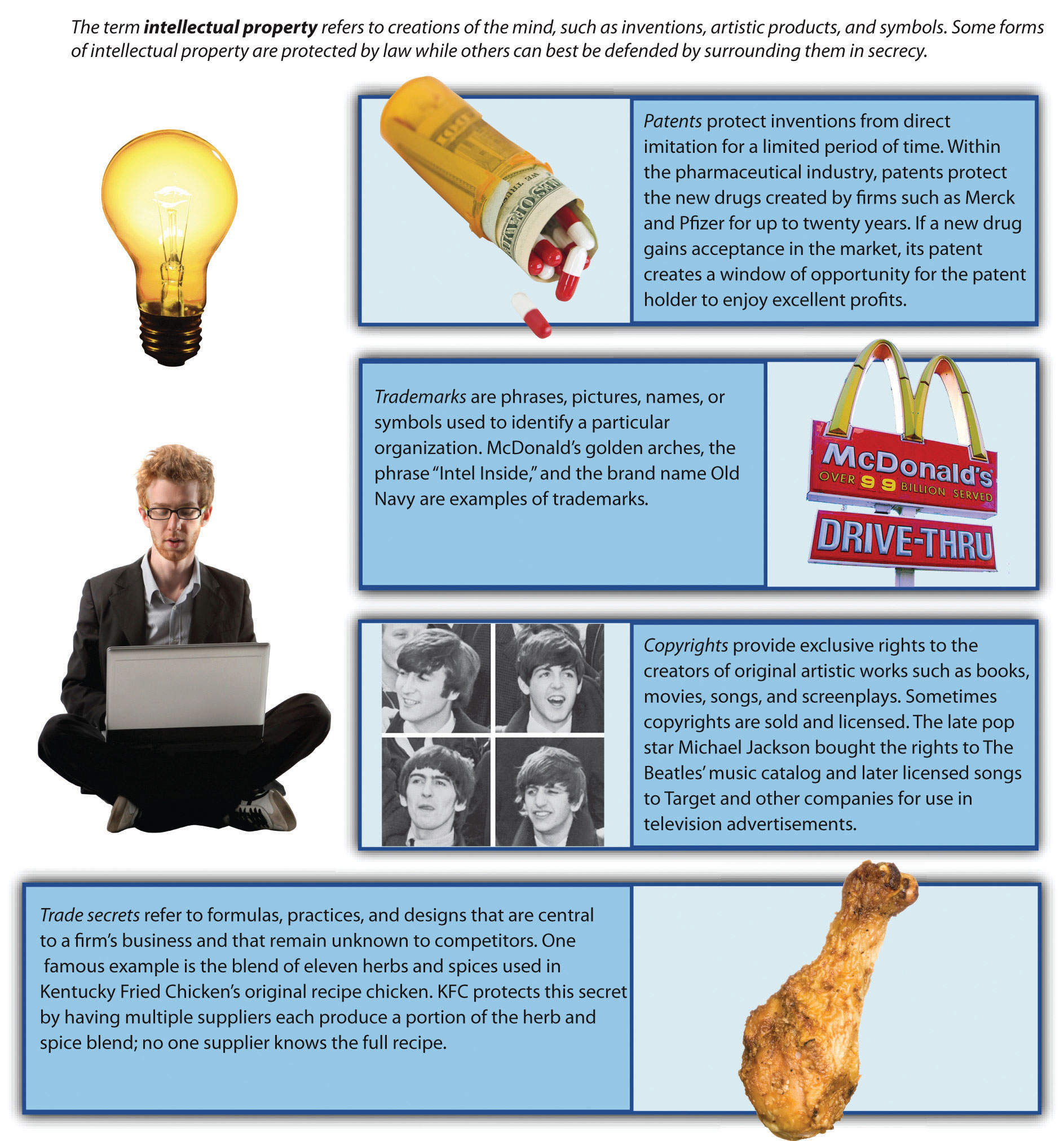
Images courtesy of Sam Smith, http://commons.wikimedia.org/wiki/File:Harlem_Micky_Dz.jpg (second); United Press International (UPI Telephoto), http://commons.wikimedia.org/wiki/File:The_Fabs.JPG (fourth); other images © Thinkstock.
Patents
Figure 4.6 Patents
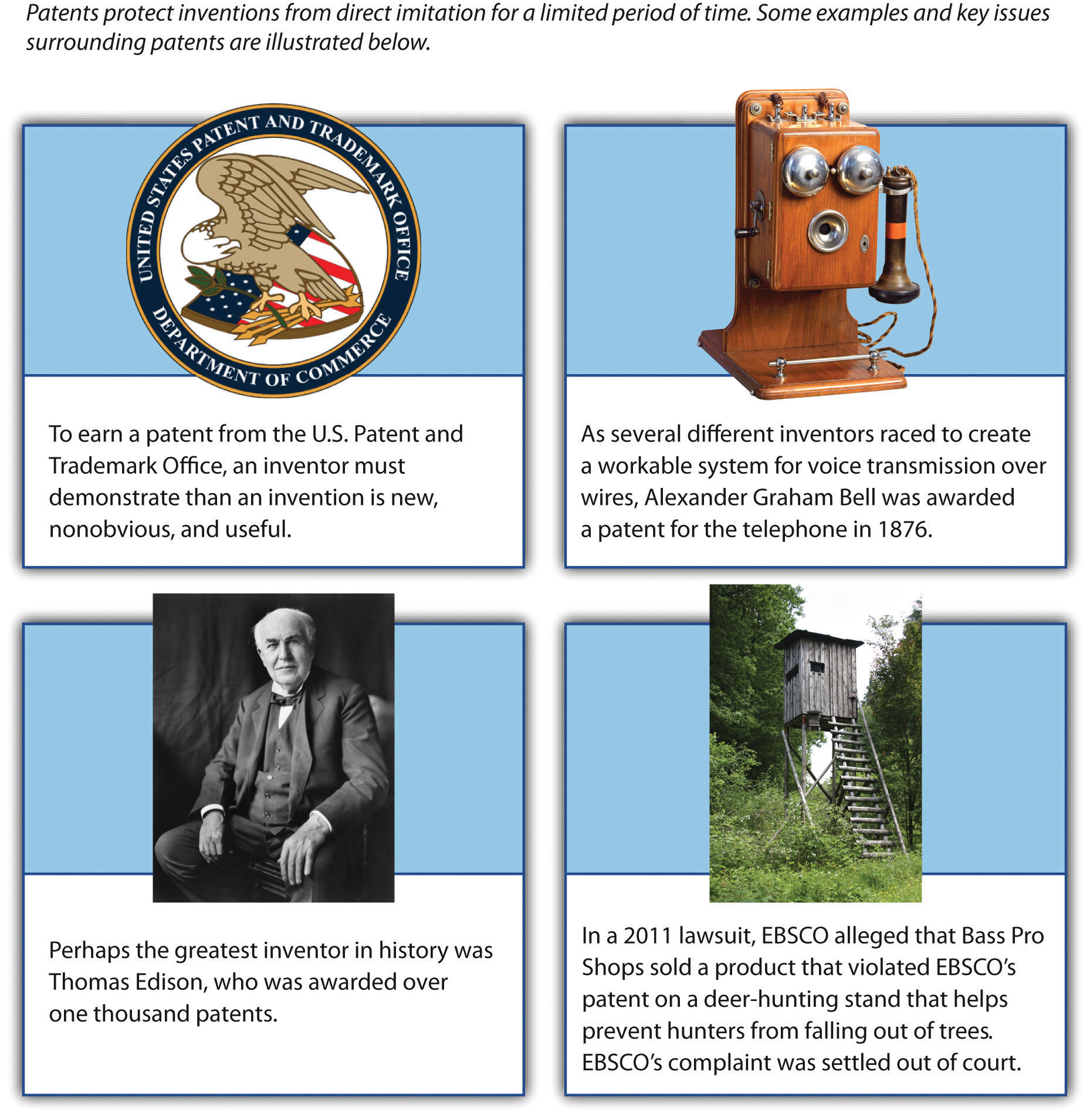
Images courtesy of US government, http://commons.wikimedia.org/wiki/File:US-PatentTrademarkOffice-Seal.svg (top left); Louis Bachrach, http://commons.wikimedia.org/wiki/File:Thomas_Edison2.jpg (bottom left); other images © Thinkstock.
PatentsLegal decree that protects inventions from direct imitation for a limited period of time. are legal decrees that protect inventions from direct imitation for a limited period of time (Figure 4.6 "Patents"). Obtaining a patent involves navigating a challenging process. To earn a patent from the US Patent and Trademark Office, an inventor must demonstrate than an invention is new, nonobvious, and useful. If the owner of a patent believes that a company or person has infringed on the patent, the owner can sue for damages. In 2011, for example, a private company named EBSCO alleged that retailer Bass Pro Shops sold a product that violated EBSCO’s patent on a deer-hunting stand that helps prevent hunters from falling out of trees. Rather than endure a costly legal fight, the two sides agreed to settle EBSCO’s complaint out of court.
Patenting an invention is important because patents can fuel enormous profits. Imagine, for example, the potential for lost profits if the Slinky had not been patented. Shipyard engineer Richard James came up with the idea for the Slinky by accident in 1943 while he was trying to create springs for use in ship instruments. When James accidentally tipped over one of his springs, he noticed that it moved downhill in a captivating way. James spent his free time perfecting the Slinky and then applied for a patent in 1946. To date, more than three hundred million Slinkys have been sold by the company that Richard James and his wife Betty created.

Patenting inventions such as the Slinky helps ensure that the invention is protected from imitation.
Image courtesy of Roger McLassus, http://upload.wikimedia.org/wikipedia/commons/f/f3/2006-02-04_Metal_spiral.jpg.
Trademarks
TrademarksPhrase, picture, name, or symbol used to identify a particular organization. are phrases, pictures, names, or symbols used to identify a particular organization (Figure 4.7 "Trademarks"). Trademarks are important because they help an organization stand out and build an identity in the marketplace. Some trademarks are so iconic that almost all consumers recognize them, including McDonald’s golden arches, the Nike swoosh, and Apple’s outline of an apple.
Other trademarks help rising companies carve out a unique niche for themselves. For example, French shoe designer Christian Louboutin has trademarked the signature red sole of his designer shoes. Because these shoes sell for many hundreds of dollars via upscale retailers such as Neiman Marcus and Saks Fifth Avenue, competitors would love to copy their look. Thus legally protecting the distinctive red sole from imitation helps preserve Louboutin’s profits.

Fashionistas instantly recognize the trademark red sole of Christian Louboutin’s high-end shoes.
Image courtesy of Arroser, http://wikimediafoundation.org/wiki/File:Louboutin_altadama140.jpg.
Trademarks are important to colleges and universities. Schools earn tremendous sums of money through royalties on T-shirts, sweatshirts, hats, backpacks, and other consumer goods sporting their names and logos. On any given day, there are probably several students in your class wearing one or more pieces of clothing featuring your school’s insignia; your school benefits every time items like this are sold.
Schools’ trademarks are easy to counterfeit, however, and the sales of counterfeit goods take money away from colleges and universities. Not surprisingly, many schools fight to protect their trademarks. In October 2009, for example, the University of Oklahoma announced that it was teaming with law enforcement officials to combat the sale of counterfeit goods around its campus.Ward, C. 2009, October 8. OU works to prevent trademark infringement. The Oklahoma Daily. Retrieved from http://www.oudaily.com/news/2009/oct/08/ou-works-prevent-trademark-infringement This initiative and similar ones at other colleges and universities are designed to ensure that schools receive their fair share of the sales that their names and logos generate.
Figure 4.7 Trademarks
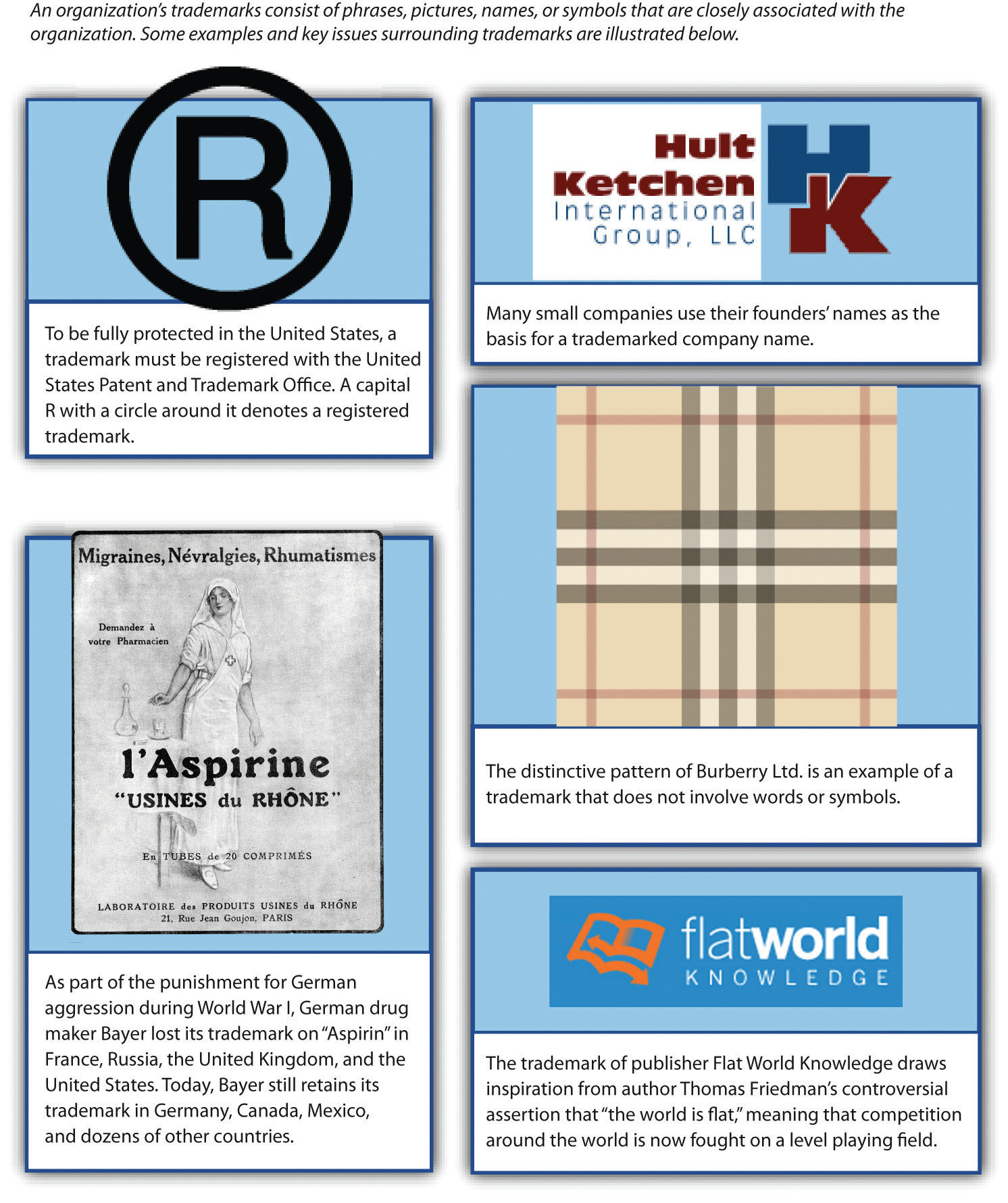
Images courtesy of unknown author, http://en.wikipedia.org/wiki/File:Aspirine-1923.jpg (bottom left); Wilinckx, http://en.wikipedia.org/wiki/File:Trademark-symbool.png (top left); Hult Ketchen International Group, LLC (top right); Helix84, http://en.wikipedia.org/wiki/File:Burrbery_check.gif (middle right); Flat World Knowledge (bottom right).
Copyrights
Figure 4.8 Copyrights
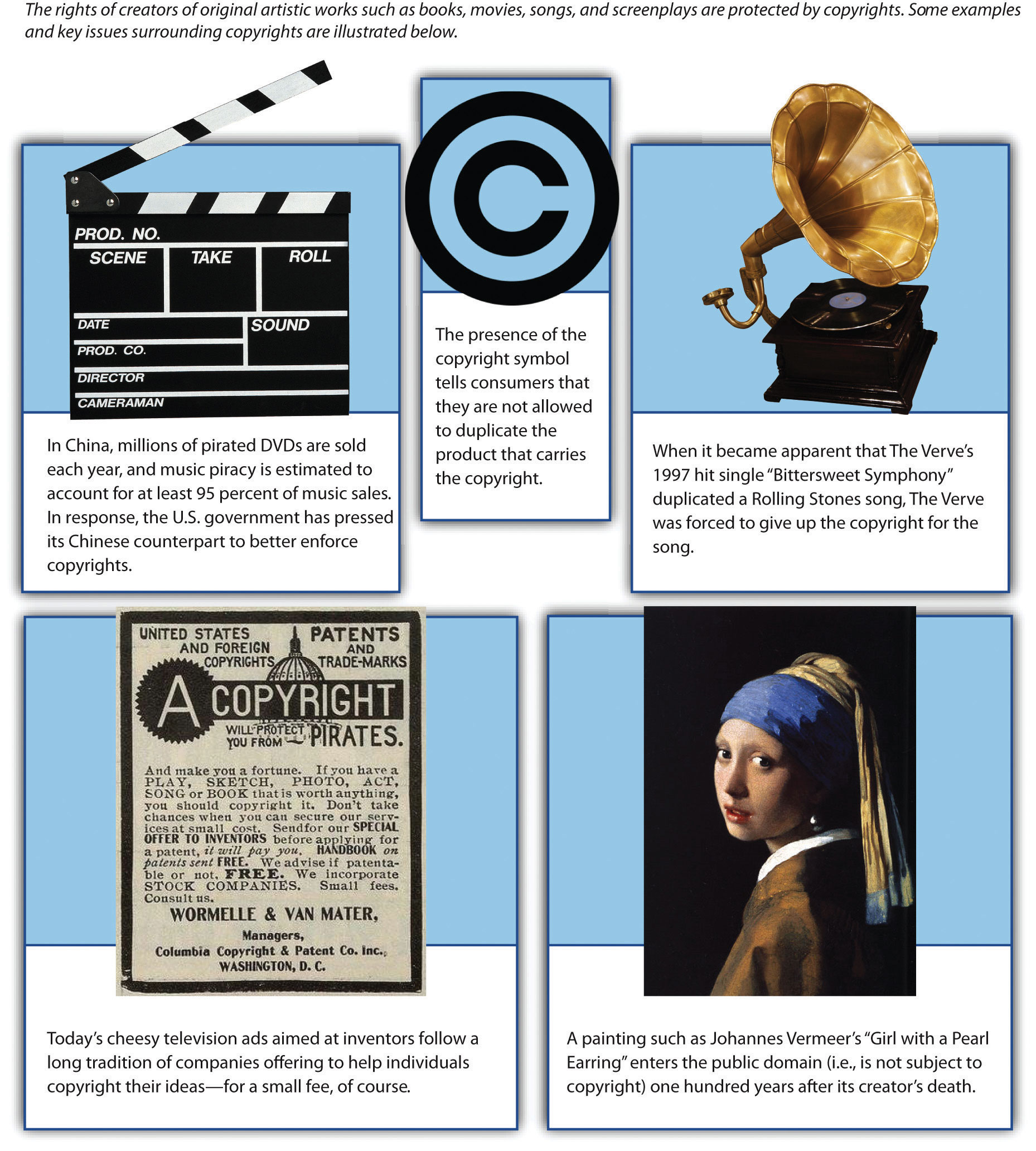
Images courtesy of Johannes Vermeer, http://en.wikipedia.org/wiki/File:Girl_with_a_Pearl_Earring.jpg (bottom right); unknown author, http://en.wikipedia.org/wiki/File:Copyright.svg (top middle); http://en.wikipedia.org/wiki/File:Newspaper_advert_copyright_patent_and_trade_mark.jpg (bottom left); other images © Thinkstock.
CopyrightsProvides exclusive rights to the creators of original artistic works such as books, movies, songs, and screenplays. provide exclusive rights to the creators of original artistic works such as books, movies, songs, and screenplays (Figure 4.8 "Copyrights"). Sometimes copyrights are sold and licensed. In the late 1960s, Buick thought it had an agreement in place to license the number one hit “Light My Fire” for a television advertisement from The Doors until the band’s volatile lead singer Jim Morrison loudly protested what he saw as mistreating a work of art. Classic rock by The Beatles has been used in television ads in recent years. After the late pop star Michael Jackson bought the rights to the band’s music catalog, he licensed songs to Target and other companies. Some devoted music fans consider such ads to be abominations, perhaps proving the merit of Morrison’s protest decades ago.
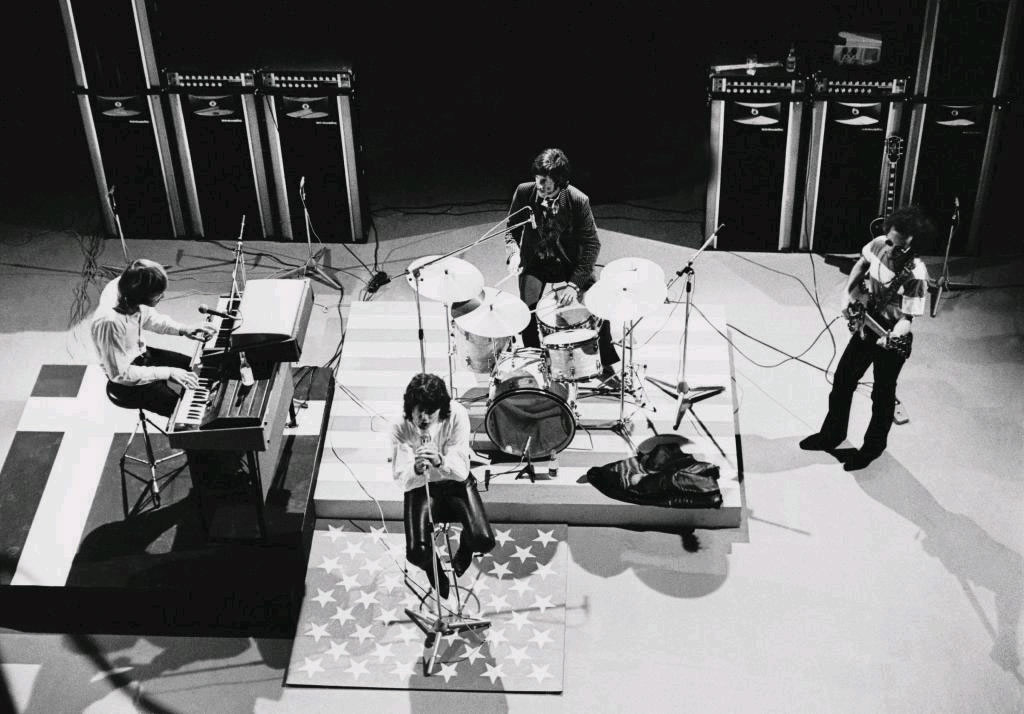
He looks calm here, but the licensing of a copyrighted song for a car commercial enraged rock legend Jim Morrison.
Image courtesy of Polfoto/Jan Persson, http://upload.wikimedia.org/wikipedia/commons/1/15/The_Doors_in_Copenhagen_1968.jpg.
Over time, piracyTheft of trademark or copyrighted material. has become a huge issue for the owners of copyrighted works. In China, millions of pirated DVDs are sold each year, and music piracy is estimated to account for at least 95 percent of music sales. This piracy deprives movie studios, record labels, and artists of millions of dollars in royalties. In response to the damage piracy has caused, the US government has pressed its Chinese counterpart and other national governments to better enforce copyrights.
Trade Secrets
Trade secretsFormulas, practices, and designs that are central to a firm’s business and that remain unknown to competitors. refer to formulas, practices, and designs that are central to a firm’s business and that remain unknown to competitors (Figure 4.9 "Trade Secrets"). Trade secrets are protected by laws on theft, but once a secret is revealed, it cannot be a secret any longer. This leads firms to rely mainly on silence and privacy rather than the legal system to protect trade secrets.
Figure 4.9 Trade Secrets
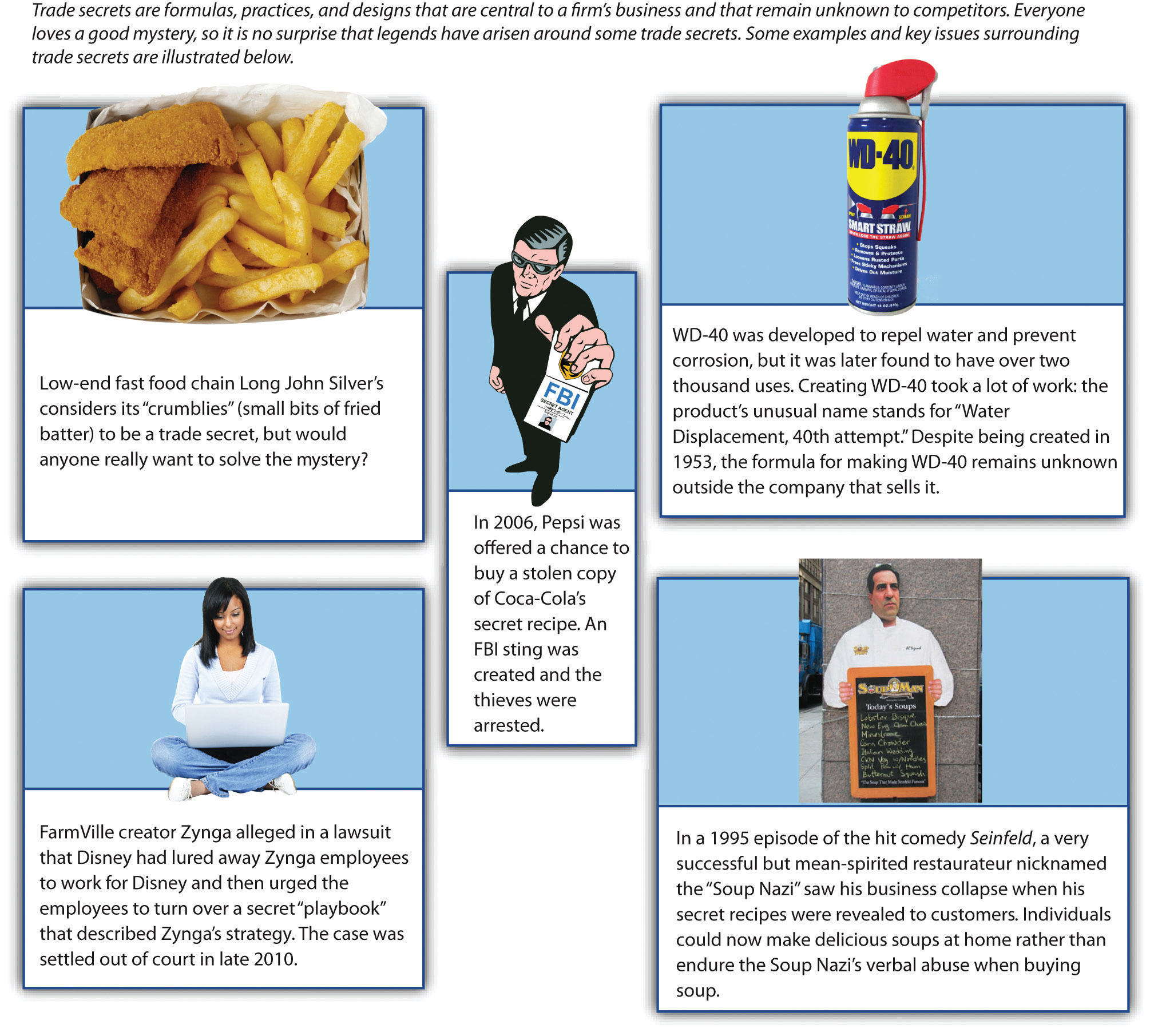
Images courtesy of Marcel Costa, http://www.flickr.com/photos/maccosta/5611261877/ (bottom right); ZooFari, http://en.wikipedia.org/wiki/File:WD-40_Smart_Straw.JPG (top right); other images © Thinkstock.
Some trade secrets have become legendary, perhaps because a mystique arises around the unknown. One famous example is the blend of eleven herbs and spices used in Kentucky Fried Chicken’s original recipe chicken. KFC protects this secret by having multiple suppliers each produce a portion of the herb and spice blend; no one supplier knows the full recipe. The formulation of Coca-Cola is also shrouded in mystery. In 2006, Pepsi was approached by shady individuals who were offering a chance to buy a stolen copy of Coca-Cola’s secret recipe. Pepsi wisely refused. An FBI sting was used to bring the thieves to justice. The soft-drink industry has other secrets too. Dr Pepper’s recipe remains unknown outside the company. Although Coke’s formula has been the subject of greater speculation, Dr Pepper is actually the original secret soft drink; it was created a year before Coca-Cola.

The recipe for Dr Pepper is a secret dating back to the 1880s.
Image courtesy of anyjazz65, http://www.flickr.com/photos/49024304@N00/4262262427/sizes/l/in/photostream.
Key Takeaway
- Intellectual property can serve as a strategic resource for organizations. While some sources of intellectual property such as patents, trademarks, and copyrights can receive special legal protection, trade secrets provide competitive advantages by simply staying hidden from competitors.
Exercises
- What designs for your college or university are protected by trademarks?
- What type of intellectual property provides the most protection for firms?
- Why would a firm protect a resource through trade secret rather than by a formal patent?
4.3 Value Chain
Learning Objectives
- Define the primary activities of the value chain.
- Know the different support activities within the value chain.
- Be able to apply the value chain to an organization of your choosing.
- Understand the difference between a value chain and supply chain.
Figure 4.10 Adding Value within a Value Chain

Image courtesy of Carol M. Highsmith, http://commons.wikimedia.org/wiki/File:Randy%27s_donuts1_edit1.jpg.
Elements of the Value Chain
When executives choose strategies, an organization’s resources and capabilities should be examined alongside consideration of its value chainA tool that charts the path by which products and services are created and eventually sold to customers.. A value chain charts the path by which products and services are created and eventually sold to customers.Porter, M. E. 1985. Competitive advantage: Creating and sustaining superior performance. New York, NY: Free Press. The term value chain reflects the fact that, as each step of this path is completed, the product becomes more valuable than it was at the previous step (Figure 4.10 "Adding Value within a Value Chain"). Within the lumber business, for example, value is added when a tree is transformed into usable wooden boards; the boards created from a tree can be sold for more money than the price of the tree.
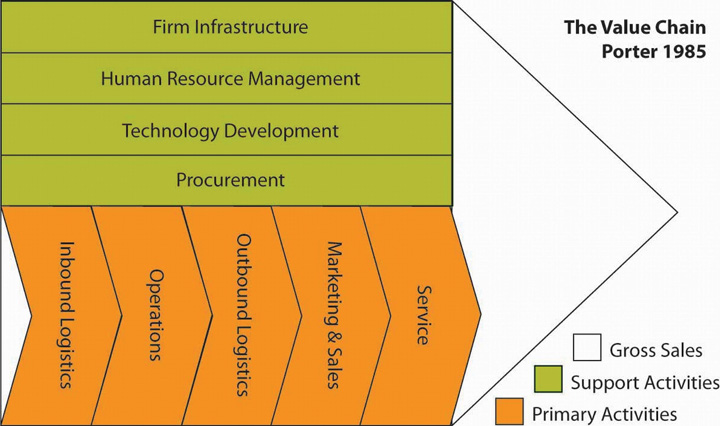
The Value Chain
Reproduced with permission from Carpenter, M., Bauer, T., & Erdogan, B. 2011. Principles of Management. Irvington, NY: Flat World Knowledge.
Value chains include both primary and secondary activities. Primary activitiesAn action directly involved in the creation and distribution of goods and services. are actions that are directly involved in creating and distributing goods and services. Consider a simple illustrative example: doughnut shops. Doughnut shops transform basic commodity products such as flour, sugar, butter, and grease into delectable treats. Value is added through this process because consumers are willing to pay much more for doughnuts than they would be willing to pay for the underlying ingredients.
There are five primary activities. Inbound logisticsThe arrival of raw materials. refers to the arrival of raw materials. Although doughnuts are seen by most consumers as notoriously unhealthy, the Doughnut Plant in New York City has carved out a unique niche for itself by obtaining organic ingredients from a local farmer’s market. OperationsThe production process of a good or service. refers to the actual production process, while outbound logistics tracks the movement of a finished product to customers. One of Southwest Airlines’ unique capabilities is moving passengers more quickly than its rivals. This advantage in operations is based in part on Southwest’s reliance on one type of airplane (which speeds maintenance) and its avoidance of advance seat assignments (which accelerates the passenger boarding process).
Attracting potential customers and convincing them to make purchases is the domain of marketing and salesActivities used to attract potential customers and convince them to make purchases.. For example, people cannot help but notice Randy’s Donuts in Inglewood, California, because the building has a giant doughnut on top of it. Finally, serviceThe extent to which a firm provides assistance to its customers. refers to the extent to which a firm provides assistance to their customers. Voodoo Donuts in Portland, Oregon, has developed a clever website (voodoodoughnut.com) that helps customers understand their uniquely named products, such as the Voodoo Doll, the Texas Challenge, the Memphis Mafia, and the Dirty Snowball.
Secondary activitiesAn action not directly involved in the evolution of a product but instead provides important underlying support for a primary activity. are not directly involved in the evolution of a product but instead provide important underlying support for primary activities. Firm infrastructureHow the firm is organized and led by executives. refers to how the firm is organized and led by executives. The effects of this organizing and leadership can be profound. For example, Ron Joyce’s leadership of Canadian doughnut shop chain Tim Hortons was so successful that Canadians consume more doughnuts per person than all other countries. In terms of resource-based theory, Joyce’s leadership was clearly a valuable and rare resource that helped his firm prosper.
Also important is human resource managementIncludes activities involved in recruiting, training, and compensating employees., which involves the recruitment, training, and compensation of employees. A recent research study used data from more than twelve thousand organizations to demonstrate that the knowledge, skills, and abilities of a firm’s employees can act as a strategic resource and strongly influence the firm’s performance.Crook, T. R., Todd, S. Y., Combs, J. G., Woehr, D. J., & Ketchen, D. J. 2011. Does human capital matter? A meta-analysis of the relationship between human capital and firm performance. Journal of Applied Psychology, 96(3), 443–456. Certainly, the unique level of dedication demonstrated by employees at Southwest Airlines has contributed to that firm’s excellent performance over several decades.
TechnologyThe use of computerization and telecommunications to support primary activities. refers to the use of computerization and telecommunications to support primary activities. Although doughnut making is not a high-tech business, technology plays a variety of roles for doughnut shops, such as allowing customers to use credit cards. ProcurementThe process of negotiating for and purchasing raw materials. is the process of negotiating for and purchasing raw materials. Large doughnut chains such as Dunkin’ Donuts and Krispy Kreme can gain cost advantages over their smaller rivals by purchasing flour, sugar, and other ingredients in bulk. Meanwhile, Southwest Airlines has gained an advantage over its rivals by using futures contracts within its procurement process to minimize the effects of rising fuel prices.
From the Value Chain to Best Value Supply Chains
“Time is money!” warns a famous saying. This simple yet profound statement suggests that organizations that quickly complete their work will enjoy greater profits, while slower-moving firms will suffer. The belief that time is money has encouraged the modern emphasis on supply chain management. A supply chainA system of people, activities, information, and resources involved in creating a product and moving it to the customer. is a system of people, activities, information, and resources involved in creating a product and moving it to the customer. A supply chain is a broader concept than a value chain; the latter refers to activities within one firm, while the former captures the entire process of creating and distributing a product, often across several firms.
Competition in the twenty-first century requires an approach that considers the supply chain concept in tandem with the value-creation process within a firm: best value supply chainsSupply chains that focus on the total value added to the customer as opposed to individual outcomes, such as speed or cost.. These chains do not fixate on speed or on any other single metric. Instead, relative to their peers, best value supply chains focus on the total value added to the customer.
Creating best value supply chains requires four components. The first is strategic supply chain managementThe use of supply chains as a means to create competitive advantages and enhance firm performance.—the use of supply chains as a means to create competitive advantages and enhance firm performance. Such an approach contradicts the popular wisdom centered on the need to maximize speed. Instead, there is recognition that the fastest chain may not satisfy customers’ needs. Best value supply chains strive to excel along four measures. Speed (or “cycle time”)The time duration from initiation to completion of the production and distribution process. is the time duration from initiation to completion of the production and distribution process. QualityThe relative reliability of supply chain activities. refers to the relative reliability of supply chain activities. Supply chains’ efforts at managing costThe price paid for supply chain inputs. involve enhancing value by either reducing expenses or increasing customer benefits for the same cost level. FlexibilityA supply chain’s responsiveness to changes in customers’ needs. refers to a supply chain’s responsiveness to changes in customers’ needs. Through balancing these four metrics, best value supply chains attempt to provide the highest level of total value added.
The value of strategic supply chain management is reflected in how firms such as Walmart have used their supply chains as competitive weapons to gain advantages over peers. Walmart excels in terms of speed and cost by locating all domestic stores within one day’s drive of a warehouse while owning a trucking fleet. This creates distribution speed and economies of scale that competitors simply cannot match. When Kmart’s executives decided in the late 1990s to compete head-to-head with Walmart on price, Walmart’s sophisticated logistics system enabled it to easily withstand the price war. Unable to match its rival’s speed and costs, Kmart soon plunged into bankruptcy. Walmart’s supply chains also possess strong quality and flexibility. When Hurricane Katrina devastated the Gulf Coast in 2005, Walmart used not only its warehouses and trucks but also its satellite technology, radio frequency identification (RFID), and global positioning systems to quickly divert assets to affected areas. The result was that Walmart emerged as the first responder in many towns and provided essentials such as drinking water faster than local and federal governments could.
Meanwhile, failing to manage a supply chain effectively causes serious harm. For example, in 2003 Motorola was unable to meet demand for its new camera phones because it did not have enough lenses available. Also, firms whose supply chains were centered in the Port of Los Angeles collectively lost more than $2 billion a day during a 2002 workers’ strike. In terms of stock price, firms’ market value erodes by an average of 10 percent following the announcement of a major supply chain problem.
The second component is agilityThe supply chain’s relative capacity to act rapidly in response to dramatic changes in supply and demand., the supply chain’s relative capacity to act rapidly in response to dramatic changes in supply and demand.Lee, H. L. 2004, October. The triple-A supply chain. Harvard Business Review, 83, 102–112. Agility can be achieved using buffers. Excess capacity, inventory, and management information systems all provide buffers that better enable a best value supply chain to service and to be more responsive to its customers. Rapid improvements and decreased costs in deploying information systems have enabled supply chains in recent years to reduce inventory as a buffer. Much popular thinking depicts inventory reduction as a goal in and of itself. However, this cannot occur without corresponding increases in buffer capacity elsewhere in the chain, or performance will suffer. A best value supply chain seeks to optimize the total costs of all buffers used. The costs of deploying each buffer differs across industries; therefore, no solution that works for one company can be directly applied to another in a different industry without adaptation.
Agility in a supply chain can also be improved and achieved by colocating with the customer. This arrangement creates an information flow that cannot be duplicated through other methods. Daily face-to-face contact for supply chain personnel enables quicker response times to customer demands due to the speed at which information can travel back and forth between the parties. Again, this buffer of increased and improved information flows comes at an expense, so executives seeking to build a best value supply chain will investigate the opportunity and determine whether this action optimizes total costs.
AdaptabilityA willingness and capacity to reshape supply chains when necessary. refers to a willingness and capacity to reshape supply chains when necessary. Generally, creating one supply chain for a customer is desired because this helps minimize costs. Adaptable firms realize that this is not always a best value solution, however. For example, in the defense industry, the US Army requires one class of weapon simulators to be repaired within eight hours, while another class of items can be repaired and returned within one month. To service these varying requirements efficiently and effectively, Computer Science Corporation (the firm whose supply chains maintain the equipment) must devise adaptable supply chains. In this case, spare parts inventory is positioned in proximity to the class of simulators requiring quick turnaround, while the less-time-sensitive devices are sent to a centralized repair facility. This supply chain configuration allows Computer Science Corporation to satisfy customer demands while avoiding the excess costs that would be involved in localizing all repair activities.
In situations in which the interests of one firm in the chain and the chain as a whole conflict, most executives will choose an option that benefits their firm. This creates a need for alignment among chain members. AlignmentCreating consistency in the interests of all participants in a supply chain. refers to creating consistency in the interests of all participants in a supply chain. In many situations, this can be accomplished through carefully writing incentives into contracts. Collaborative forecasting with suppliers and customers can also help build alignment. Taking the time to sit together with participants in the supply chain to agree on anticipated business levels permits shared understanding and rapid information transfers between parties. This is particularly valuable when customer demand is uncertain, such as in the retail industry.This section of the chapter is adapted from Ketchen, D. J., Rebarick, W., Hult, G. T., & Meyer, D. 2008. Best value supply chains: A key competitive weapon for the 21st century. Business Horizons, 51, 235–243.
Key Takeaway
- The value chain provides a useful tool for managers to examine systematically where value may be added to their organizations. This tool is useful in that it examines key elements in the production of a good or service, as well as areas in which value may be added in support of those primary activities.
Exercises
- If you were hired as a consultant for your university, what specific element of the value chain would you seek to improve first?
- What local business in your town could be improved most dramatically by applying the value chain? Would improvements of primary or support activities help to improve this firm most? Could knowledge of strategic supply chain management add further value to this firm?
4.4 Beyond Resource-Based Theory: Other Views on Firm Performance
Learning Objectives
- Be able to discuss other theories about firm success and failure beyond resource-based theory.
- Be able to apply different theories to help explain competition in different industries.
Figure 4.11 Other Theories about Firm Performance
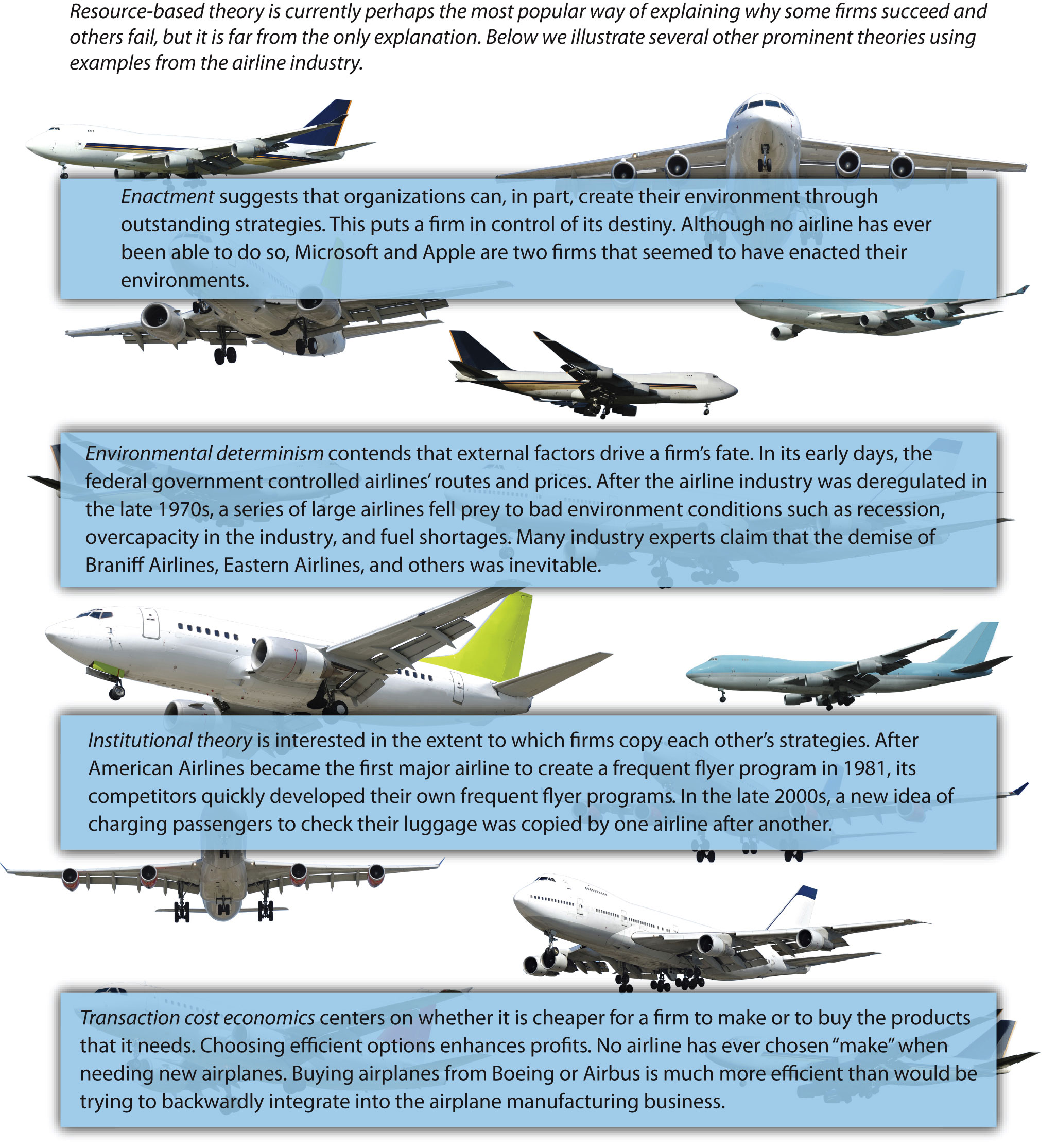
© Thinkstock
Although resource-based theory stands as perhaps the most popular explanation of why some organizations prosper while others do not, several other theories are popular. EnactmentA theoretical perspective that contends that an organization can, at least in part, create an environment for itself that is beneficial to the organization by putting strategies in place that reshape competitive conditions in a favorable way. treats executives as the masters of their domains. Enactment contends that an organization can, at least in part, create an environment for itself that is beneficial to the organization. This is accomplished by putting strategies in place that reshape competitive conditions in a favorable way (Figure 4.11 "Other Theories about Firm Performance").
By the 1990s, Microsoft had been so successful at reshaping the software industry to its benefit that the firm was the subject of a lengthy antitrust investigation by the federal government. More recently, Apple has been able to reshape its environment by introducing products such as the iPhone and the iPad that transcend the traditional boundaries between the cell phone, digital camera, music player, and computer businesses. No airline has ever been able to enact the environment, however, perhaps because the airline industry is so fragmented.
Environmental determinismA theoretical perspective that contends that organizations are limited in their ability to adapt to the conditions around them. offers a completely opposite view from enactment on why some firms succeed and others fail. Environmental determinism views organizations much like biological theories view animals—organizations (and animals) are very limited in their ability to adapt to the conditions around them. Thus just as harsh environmental changes are believed to have made dinosaurs extinct, changes in the business environment can destroy organizations regardless of how clever and insightful executives are.
Until 1978, the federal government regulated the airline industry by dictating what routes each airline would fly and what prices it would charge. Once these controls were removed, airlines were subjected to a series of negative environmental trends, including recession, overcapacity in the industry, new entrants, fierce price competition, and fuel shortages. Perhaps not surprisingly, dozens of airlines have been crushed by these conditions.
An old saying notes that “imitation is the sincerest form of flattery.” This flattery is the focus of institutional theoryThe extent to which firms copy one another’s strategies.. In particular, institutional theory centers on the extent to which firms copy one another’s strategies. Consider, for example, fast-food hamburger restaurants. Innovations such as dollar menus and drive-through windows tend to be introduced by one firm and then duplicated by the others.
Airlines also seem to follow a “monkey see, monkey do” mentality. To build passenger loyalty, American Airlines introduced a frequent flyer program called AAdvantage in 1981. After flying a certain number of miles on American flights, AAdvantage members were rewarded with a free flight. The idea was to make passengers less likely to shop around for the cheapest ticket. Ironically, AAdvantage turned out to be not much of an advantage at all. Many of American’s rivals quickly developed their own frequent-flyer programs, and today most airlines reward frequent passengers. In recent years, ideas such as charging passengers to check their luggage and eliminating free food on flights have been copied by one airline after another.
Transaction cost economicsA theory that centers on whether it is cheaper for a firm to make or to buy the products that it needs. is a theory that centers on just one element of business activity: whether it is cheaper for a firm to make or to buy the products that it needs. This is an important element, however, because choosing the more efficient option can enhance a firm’s profits. Automakers such as Ford and General Motors face a wide variety of make-or-buy decisions because so many different parts are needed to build cars and trucks. Sometimes Ford and GM make these products, and other times they purchase them from outside suppliers. These firms’ financial situations are improved when these decisions are made wisely and harmed when they are made poorly.
In contrast, airlines always buy (or rent) their airplanes. Large planes are generally bought from Boeing or Airbus, while modest-sized airliners are purchased from companies such as Brazil’s Embraer. It would be simply too costly for an airline to pursue a backward integration strategyA firm that enters the business of one of its suppliers. and enter the airplane manufacturing business. Insights such as these are powerful enough that the creator of transaction cost economics, Professor Oliver Williamson, was awarded a Nobel Prize in Economic Sciences in 2009.
Each of these theories—enactment, environmental determinism, institutional theory, and transaction cost economics—is useful for understanding some situations and some important business decisions. Thus executives should keep these perspectives in mind as they attempt to lead their firms to greater levels of success. However, one important advantage that resource-based theory offers over the alternatives is that only resource-based theory does a good job of explaining firm performance across a wide variety of contexts. Thus resource-based theory offers the point of view of business that has the strongest value for most executives.
Key Takeaway
- Although resource-based theory is the dominant perspective to predict performance in the strategic management field, other theories exist to explain firm behavior. In some industries, explanations provided by these theories can be very convincing.
Exercises
- What theory of the firm do you think best explains competition in the fast-food industry?
- What is an example of an industry in which institutional theory seems to explain the behavior of firms?
4.5 SWOT Analysis
Learning Objectives
- Understand what SWOT analysis is.
- Learn how SWOT analysis can help organizations and individuals, and its limitations.
Figure 4.12 SWOT
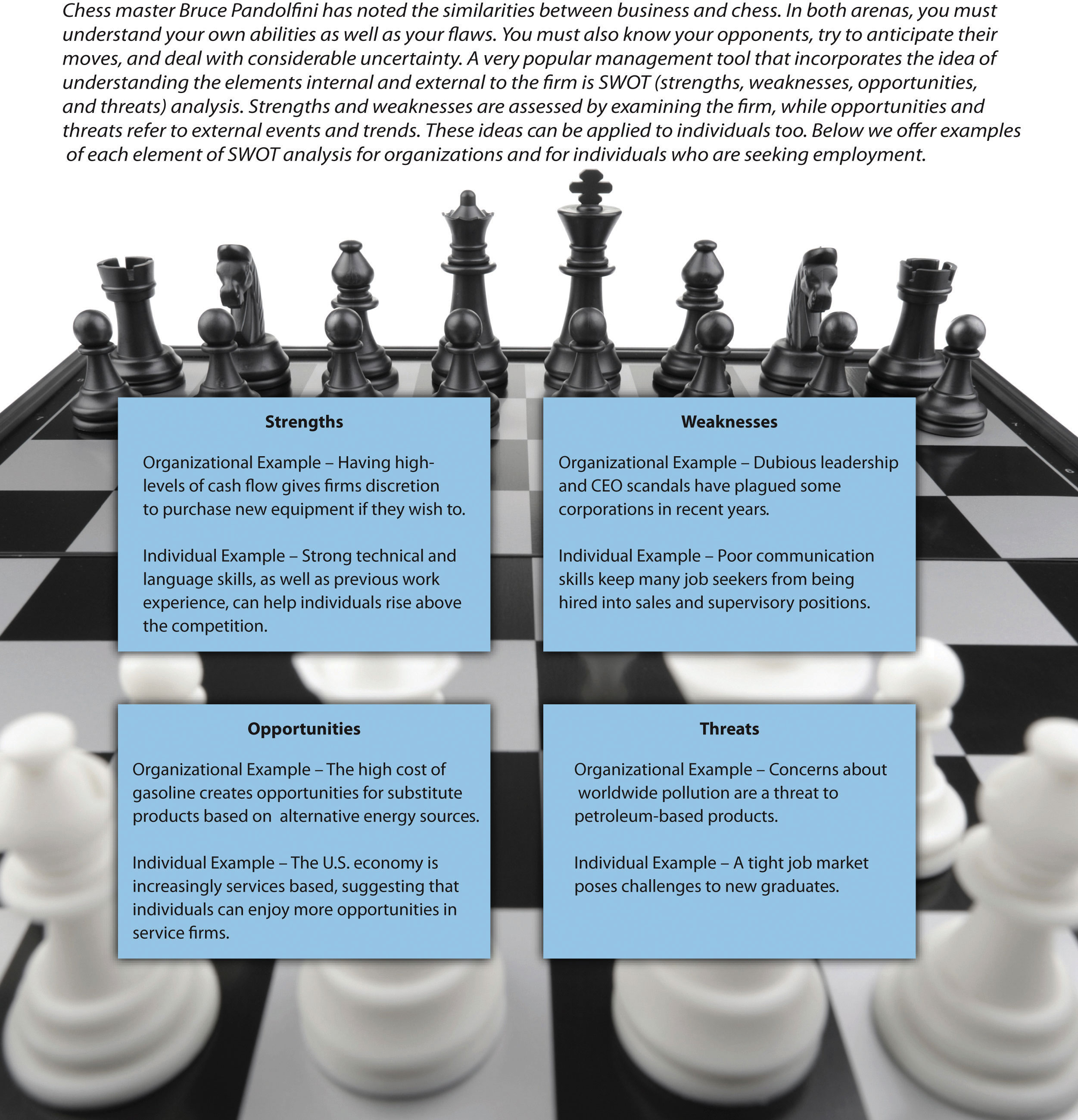
© Thinkstock
Five forces analysis examines the situation faced by the competitors in an industry. Strategic groups analysis narrows the focus by centering on subsets of these competitors whose strategies are similar. SWOT analysisA technique for understanding a firm’s situation by considering its strengths and weaknesses, along with the opportunities and threats that exist in the firm’s environment. takes an even narrower focus by centering on an individual firm. Specifically, SWOT analysis is a tool that considers a firm’s strengths and weaknesses along with the opportunities and threats that exist in the firm’s environment (Figure 4.12 "SWOT").
Executives using SWOT analysis compare these internal and external factors to generate ideas about how their firm might become more successful. In general, it is wise to focus on ideas that allow a firm to leverage its strengths, steer clear of or resolve its weaknesses, capitalize on opportunities, and protect itself against threats. For example, untapped overseas markets have presented potentially lucrative opportunities to Subway and other restaurant chains such as McDonald’s and Kentucky Fried Chicken. Meanwhile, Subway’s strengths include a well-established brand name and a simple business format that can easily be adapted to other cultures. In considering the opportunities offered by overseas markets and Subway’s strengths, it is not surprising that entering and expanding in different countries has been a key element of Subway’s strategy in recent years. Indeed, Subway currently has operations in nearly 100 nations.

China’s huge population and growing wealth makes it an attractive opportunity for Subway and other American restaurant chains.
© Thinkstock
SWOT analysis is helpful to executives, and it is used within most organizations. Important cautions need to be offered about SWOT analysis, however. First, in laying out each of the four elements of SWOT, internal and external factors should not be confused with each other. It is important not to list strengths as opportunities, for example, if executives are to succeed at matching internal and external concerns during the idea generation process. Second, opportunities should not be confused with strategic moves designed to capitalize on these opportunities. In the case of Subway, it would be a mistake to list “entering new countries” as an opportunity. Instead, untapped markets are the opportunity presented to Subway, and entering those markets is a way for Subway to exploit the opportunity. Finally, and perhaps most important, the results of SWOT analysis should not be overemphasized. SWOT analysis is a relatively simple tool for understanding a firm’s situation. As a result, SWOT is best viewed as a brainstorming technique for generating creative ideas, not as a rigorous method for selecting strategies. Thus the ideas produced by SWOT analysis offer a starting point for executives’ efforts to craft strategies for their organization, not an ending point.
In addition to organizations, individuals can benefit from applying SWOT analysis to their personal situation. A college student who is approaching graduation, for example, could lay out her main strengths and weaknesses and the opportunities and threats presented by the environment. Suppose, for instance, that this person enjoys and is good at helping others (a strength) but also has a rather short attention span (a weakness). Meanwhile, opportunities to work at a rehabilitation center or to pursue an advanced degree are available. Our hypothetical student might be wise to pursue a job at the rehabilitation center (where her strength at helping others would be a powerful asset) rather than entering graduate school (where a lot of reading is required and her short attention span could undermine her studies).
Key Takeaway
- Executives using SWOT analysis compare internal strengths and weaknesses with external opportunities and threats to generate ideas about how their firm might become more successful. Ideas that allow a firm to leverage its strengths, steer clear of or resolve its weaknesses, capitalize on opportunities, and protect itself against threats are particularly helpful.
Exercises
- What do each of the letters in SWOT represent?
- What are your key strengths, and how might you build your own personal strategies for success around them?
4.6 Conclusion
This chapter explains key issues that executives face in managing resources to keep their firms competitive. Resource-based theory argues that firms will perform better when they assemble resources that are valuable, rare, difficult to imitate, and nonsubstitutable. When executives can successfully bundle organizational resources into unique capabilities, the firm is more likely to enjoy lasting success. Different forms of intellectual property—which include patents, trademarks, copyrights, and trade secrets—may also serve as strategic resources for firms. Examining a firm’s resources can be aided by the value chain, a tool that systematically examines primary and secondary activities in the creation of a good or service and by a knowledge of supply chain management that examines the value added of multiple firms working together. While resource-based theory provides a dominant view for examining the determinants of firm success, other perspectives provide insight for understanding specific behaviors of firms within an industry. Finally, SWOT analysis is a simple but powerful technique for examining the interactions between factors internal and external to the firm.
Exercises
- Divide your class into four or eight groups, depending on the size of the class. Each group should search for a patent tied to a successful product, as well as a patent associated with a product that was not a commercial hit. Were there resources tied to the successful organization that the poor performer did not seem to attain?
- This chapter discussed Southwest Airlines. Based on your reading of the chapter, how well has Southwest done in bundling together the resources recommended by resource-based theory? What theoretical perspective best explains the competitive actions of most firms in the airline industry?
- Conduct a SWOT analysis of your college or university. Based on your analysis, what one strategic move should your school make first, and why?




